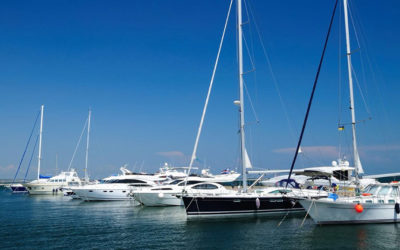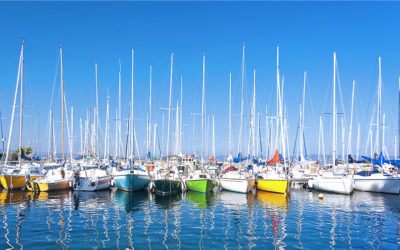Antifouling is a paint used to prevent fouling, i.e. the growth of aquatic organisms on the hull. Band of Boats helps you find the right antifouling product for your boat.
1. Why apply antifouling?
The regular application of antifouling protects the parts of the boat that are below the waterline. Without antifouling, the hull can deteriorate, slow the boat, and increase fuel consumption.
Handy tip: The application of one or two coats of primer is strongly recommended, especially for aluminium boats, to insulate the copper.
2. How to apply antifouling
It is essential to prepare the hull before applying antifouling.
Some guidelines to remember:
- The hull must be very lightly sanded with a fine grade abrasive to promote the adhesion of the next application, and then degreased, rinsed, thoroughly dry and dust-free.
- Take care to comply with the drying times according to temperature, as indicated by the manufacturer, before launching.
- It is advisable not to apply antifouling too long before the launch, because the paint oxidises more quickly in contact with air. It then loses its mechanical properties. (This time should not exceed three months.)
3. Which antifouling should I choose?
There are several types of commercially-available antifouling product to protect the bottom of any type of hull: polyester, aluminium, steel, carbon, or wood.
Band of Boats has listed the various types. Please refer to:
| Type of antifouling | Uses, characteristics | Surface coverage | Price |
| Hard matrix | Mainly used for boats that travel at above 25 knots and/or located in current zones (gel coat, steel, wood) | 9m²/L |
€50 |
| Long-life erodible | Gel coat, steel, wood, aluminium and carbon | 9m²/L | €55 |
| Ecological | Gel coat, steel, wood | 8 m²/L | €70 |
| Teflon | Hard coating, low friction, optimises gliding | NC | NC |
| Single coat | A single application (in 24 hours) for one season with average fouling on gel coat, steel, and wood | 9m²/L | €40 |
| Economical | For short-term maintenance in low to average fouling zones (gel coat, steel, and wood) | 9m²/L | €30 |
| Competition | Special regatta, hard and smooth surface without sanding (gel coat, steel, wood, carbon) against high fouling | 9m²/L | €55 to €70 |
| Long life | Intended to last 18 months (aluminium, gel coat, steel, carbon and wood) | 8m²/L | €55 to €150 |
| Aerosol | Special for propellers, pylons (aluminium, composite, stainless steel) | NC | €30 |
| Self-polishing copolymers | Soft water and salt water, without negative impact on the environment, 24-month protection, reserved for professionals | NC | €300 |
The prices mentioned are for information only, to allow comparisons
4. How do the different types of antifouling work?
1) Antifouling with self-polishing polymers:
With self-polishing polymer antifoulings, the paint film wears gradually and regularly over time and has a continuously active surface (even when the boat is immobile). Almost no inert layer will remain at the next careening. This antifouling is particularly suitable for boats that do not sail much.
2) Erodible and semi-erodible antifouling:
In erodible and semi-erodible antifouling, the release of active ingredients is triggered by wear of the film during movements of the boat. The inert layer thickens when the boat is still. Erodibility occurs only during sailing. The effectiveness is long-lasting.
3) Hard matrix antifouling:
With hard matrix antifouling, the thickness of the coats applied changes little throughout the season. The inert layer thickens regularly and becomes viscous. This chemical reaction slows and prevents the appearance of the oily film and the growth of algae and seashells. Many boaters use this antifouling when their boat is already several years old.
Now you know: antifouling is a necessary and tricky operation required for the care of your boat. Take the time to help your boat stay youthful!

